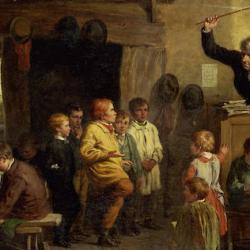David Smith and Susan Felch devote several pages of their Teaching and Christian Imagination (129–134) to a summary of John Amos Comenius’s seventeenth-century treatise on education, Great Didactic. Comenius starts where humanity starts, with Eden’s garden, and reflects that the garden is not only man’s original location but an image of what human beings are created to be.
“For as Paradise was the pleasantest part of the world, so also was man the most perfect of things created. In Paradise each tree was delightful to look at, and more pleasant to enjoy than those which grew throughout the earth. In man, the whole material of the world, all the forms and the varieties of forms were, as it were, brought together into one in order to display the whole skill and wisdom of God. Paradise contained the tree of the knowledge of good and evil ; man had the intellect to distinguish, and the will to choose between the good and the bad.”
Each man, Comenius argues, is “a Garden of Delights for his God, as long as he remains in the spot where he has been placed. The Church too, which is a collection of men devoted to God, is often in Holy Writ likened to a Paradise, to a garden, to a vineyard of God.”
He gets specific: “In Paradise was the tree of life. In man was the tree of Immortality itself; that is to say, the wisdom of God, which had planted its eternal roots in man (Ecclesiasticus 1.14). Rivers went out from the place of delight to irrigate Paradise, thence dividing into four heads (Genesis 2.10). Into man’s heart flowed various gifts of the Holy Spirit, to irrigate him, and in turn living waters flowed out from his belly (John 7:38), that is, in man and through man is poured forth the manifest wisdom of God, just as if rivers divided in every direction.”











